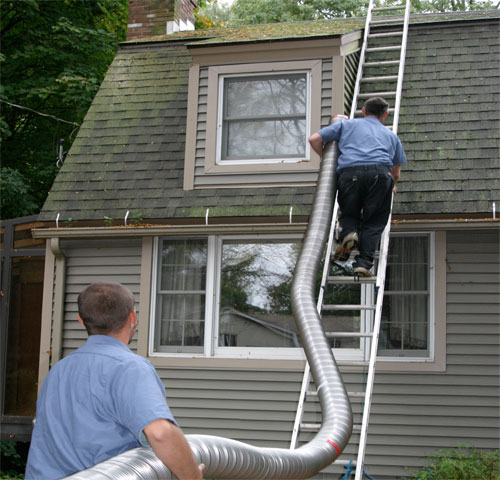Is It Time To Replace Your Chimney Liner
 The chimney and chimney liner work together to protect your Kansas City home and keep your family safe while you’re enjoying the warmth of a fireplace. The chimney liner is an essential safety component that protects the masonry from the high heat and flames in the firebox. When the chimney liner is damaged due to its age, moisture, or other issues, there is an increased risk of the intense heat spreading to nearby combustible building materials, such as the attic or a wood-framed chimney chase, that can cause a house fire. A damaged liner also increases the risk of exposure to dangerous carbon monoxide fumes.
The chimney and chimney liner work together to protect your Kansas City home and keep your family safe while you’re enjoying the warmth of a fireplace. The chimney liner is an essential safety component that protects the masonry from the high heat and flames in the firebox. When the chimney liner is damaged due to its age, moisture, or other issues, there is an increased risk of the intense heat spreading to nearby combustible building materials, such as the attic or a wood-framed chimney chase, that can cause a house fire. A damaged liner also increases the risk of exposure to dangerous carbon monoxide fumes.
It’s often difficult for homeowners to assess the condition of a chimney liner without a professional chimney inspection. However, if you notice any of the following signs of trouble, it may be time to replace your liner.
Clay Material in the Firebox
Many older homes still have the original clay tile chimney liner that has exceeded their expected 20-to-30-year lifespan. In addition, creosote buildup, moisture, and a chimney fire can damage the liner causing the clay tiles to flake, crack and burst, accelerating its deterioration. It also shortens its lifespan considerably. You may notice flakes or chunks of clay material in the firebox when this occurs. As the chimney liner continues to deteriorate, the risk of fire and exposure to carbon monoxide also increases, making it unsafe to operate your fireplace or heating stove.
Moisture or Condensation
Clay tile chimney liners are porous materials that weaken when exposed to moisture or condensation. For example, a chimney leak due to worn flashing or cracks in the masonry or chimney crown can expose the chimney liner to water damage when it rains. The moisture weakens the chimney liner that can cause it to crack. Also, when the warm interior air mixes with the cold exterior air, the chimney liner can sweat, resulting in condensation if there are any cracks in the masonry and liner. Both are signs that indicate that a chimney liner replacement may be necessary.
New Fireplace or Insert Installation
Chimney liners must meet the manufacturer’s specifications for the heating appliance to operate safely and meet building code regulations. Anytime you are converting from one fuel type to another or installing a new fireplace or insert, the chimney liner will need to be replaced following the specifications for your new heating appliance. Installing a new fireplace with an existing chimney liner that doesn’t meet the manufacturer’s specs can result in performance and safety issues.
Chimney Inspection
Your chimney liner is an essential safety component for protecting your home and family from a devastating fire and exposure to harmful fumes. A chimney inspection is the only way to determine whether it’s time to replace your chimney liner. That’s why national fire safety experts and chimney professionals, including Fluesbrothers, encourage all homeowners with solid or liquid fuel appliances to have annual chimney inspections.
A chimney inspection is a top-to-bottom interior/exterior visual examination of the entire chimney system, including the chimney liner, vents, and attached heating appliances. If a chimney liner replacement is necessary, we typically recommend UL-listed stainless-steel liners for improved energy
efficiency, fewer chimney repairs, and long-lasting durability.
Chimney Liner Replacement in Kansas City KS/MO
Fluesbrothers Chimney & Fireplace is a National Chimney Sweep Guild (NCSG) Certified Chimney Reliner. We have been providing homeowners throughout the Kansas City Metro area with quality chimney services, including certified chimney inspections and chimney liner repairs and replacements for more than a decade. Call (913) 236-7141 or contact us here to schedule an appointment with a certified chimney technician today.
The post Is It Time To Replace Your Chimney Liner appeared first on Fluesbrothers Chimney Service.